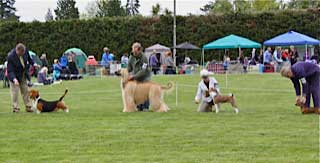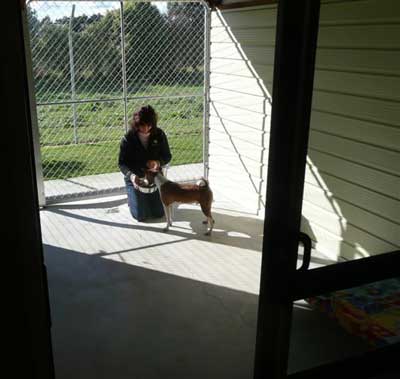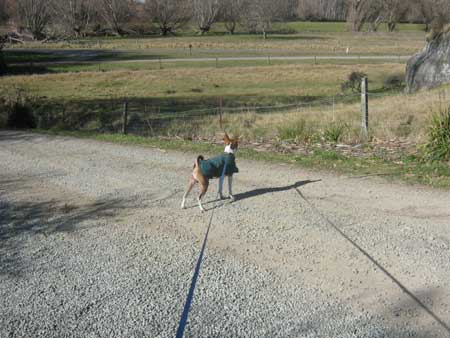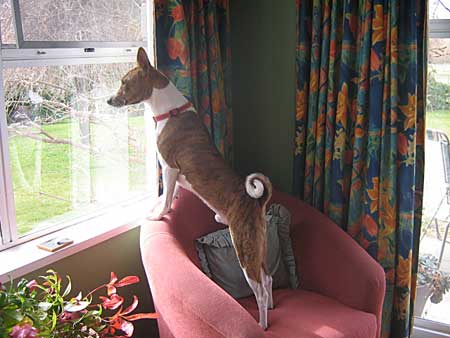Page 6 < previous page > <next page>
Exporting a dog to a foreign country (in this case, New Zealand)
is not for the faint of heart; nor is it for those who have trouble paying scrupulous attention to details.
by Chris Maxka
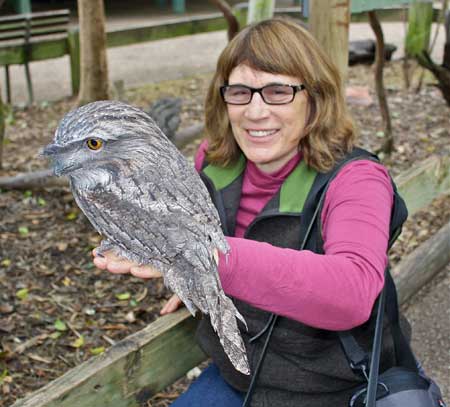 Chris with a Tawny Frogmouth
Chris with a Tawny Frogmouth
That said, import requirements vary widely from country to country. To enter the USA, for example, a dog needs only a Rabies vaccination and a health certificate. When our Puzzle, then our Q, each went to different countries in Europe, only slightly more was required. But on the other end of the spectrum lies…New Zealand.
At this point I don't even remember how I got the idea to send Pirandello to New Zealand once his US championship was finished, but if I had understood the full extent of what was going to be required of me, I might not have even started.
New Zealand is an island nation, and is blessed in that many of the diseases we have in the USA are not present. They would also like to keep it that way. I gather that Rabies is the biggest concern, but the list of other diseases was not insignificant, and the timing and sequence of the tests and treatments was precise.
 Lake Tekapo & Southern Alps
Lake Tekapo & Southern Alps
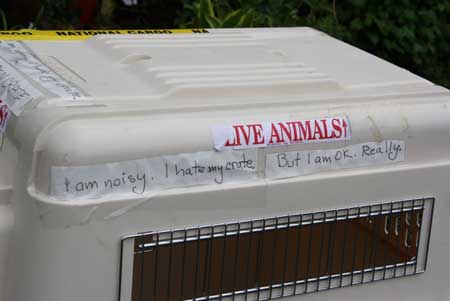
First, a word on microchips. Pirandello has had a microchip since he was a puppy, an AVID chip given when at a clinic. The microchip number is required on all test papers, so each time the vet would scan the number. However, we did not discover, until less than two weeks before Pirandello was to fly to New Zealand, that his microchip was inadequate for international travel. His AVID chip had only 9 numbers, and the international chip has 14 numbers. I called AVID directly, who informed me that they have two types of chips, one for domestic location, one for international travel. Who knew!! Not even my vet, who kindly scheduled for us an emergency appointment for a new microchip. My vet gives Home Away chips, which are all approved for international travel. I gave AVID a piece of my mind, after I read their entire brochure three times to conclude that nowhere does it mention the two types of chips. Once my vet put in the second microchip, he was required to write a letter to the New Zealand import authority that Pirandello was the same Pirandello who had previously received all the tests and treatments, and that the AVID microchip number on those test results corresponded with the new Home Again microchip number designated in his letter and on subsequent tests.
A dog must first be 9 months old before it can be imported to New Zealand. Certain breeds and mixes of breeds, including Pit Bulls, are not allowed to be imported to New Zealand. I was required to fill out a Breeder's document, signed and stamped by a Notary Public, that Pirandello was not a Pit Bull or one of the other banned breeds.
The Rabies vaccination was the first treatment, followed by a Rabies titer test, an expensive blood draw sent to a specific US Government laboratory in Missouri, at least three weeks later. When it came time for certification, everyone paid special attention to the timing, counting the months, between the vaccination and the titer. Pirandello could leave for New Zealand 6 months after the titer, but not more than 24 months after the titer. Otherwise, a new titer test, and a second 6 month wait was required. Meanwhile, his Rabies vaccinations had to be kept up to date according to New Zealand standards, which was annual, not 3-year. If the vaccination "lapsed," the entire process would have to start over. I caught this detail the day before his one year vaccination would have "lapsed"…another "emergency" visit to the vet.
Once the Rabies testing was completed, there was another step I thought was completely unnecessary. The vaccination schedule and titer had to be certified by an official veterinarian of the US Department of Agriculture. I did not trust the mail and the timing to send the papers up to the state capitol and get them back, so I called and made an appointment, and drove to Trenton, papers in hand. I had checked and double-checked, and everything was in order. I was glad I had been so careful, because the man in line before me did not have some crucial item, and had to leave, figure it out, and return later. In my case, the veterinarian signed, and made the embossed seal on the document. However, you just can't predict what will go wrong. I scanned and emailed all the documents to the importer, Roz, in New Zealand, and she submitted them for Pirandello's import permit. The word came back that the New Zealand authorities couldn't read the writing on the embossed seal of the USDA. I tried everything, I took photographs in slanted light, I sketched a pencil lightly across the seal, I darkened the signature. We were rejected three times, I believe, and my husband was about to start PhotoShopping the seal when Roz called. The authorities had relented and decided to accept the document when Roz finally broke into angry tears.
Once Pirandello's American championship was finished, a 30-day countdown started. My vet and I both spent some time studying the requirements, and made a schedule. The first round of tests and treatments had to be within 30 days of his departure. The first appointment included either a Leptospirosis titer test or vaccination. I chose the test rather than the treatment, as Pirandello had never had a Leptospirosis vaccination. If the dog has had a vaccination, it is possible to get a false positive on the titer. The titer tested for several strains of Leptospirosis, and Pirandello was cleared of all of them. Also on the 30 day appointment, Pirandello had both internal and external parasite treatments. The internal treatment was Droxel, for nematodes and cestodes. A second treatment was required within 4 days of shipping. The external parasite (tick and flea) treatment was Frontline, so I brought my own packet from home, and applied it in the vet's office in front of the vet, so he could certify the treatment. A second treatment was required within 2 days of shipping. The second appointment was within 16 days of shipment. At this time, more blood was drawn, and Pirandello was tested for Brucellosis and Babesia Gibsoni, a tick-born illness. If he had been to South Africa, he would have also had to be tested for Babesia Canis, but since he had not, this one was waived. The New Zealand authorities do not want the dog to arrive on the weekend, and the International Dateline adds two "days" to the trip. Furthermore, a specialized shipping agency is required; without one you cannot ship your dog to New Zealand, even if you are flying along. Pirandello went to Jet Pets in Los Angeles, where he was taken out of his crate, kenneled a day and a half, and given a final USDA inspection. |
Therefore, the timing of the final vet appointment here on the East Coast of the USA was delicate. The appointment had to be on a Monday, Pirandello had to fly on a Tuesday morning, so that he could arrive in Los Angeles Tuesday afternoon, meet the USDA inspector Wednesday morning, and fly to New Zealand Wednesday night, arriving Friday, getting another inspection, then off to the quarantine kennel for 10 days.
I said before, you never know what can go wrong. I now discovered that my vet, who had faithfully slogged through all Pirandello's tests and treatments with me…was on vacation THE critical Monday. Not to panic, he suggested another vet, and Pirandello and I arrived with a thick file of papers for the poor young woman to go through and sign. I spent an hour or more before the appointment, putting the papers all in order so that she could go step by step, sign, and give Pirandello his health certificate and final treatments. Those treatments were a Heartworm treatment (she watched while I fed him his pill) an internal and an external parasite treatment (my Frontline, again), and another dose of Droxel. She carefully read each previous test result, my vet's letter about the microchip, and filled out an international health certificate. I had sent all the test results and affidavits, as I got them, to the Jet Pets agency, so that their agent was following my progress and catching my mistakes. The worst case scenario would be if the poor dog were to arrive in Los Angeles and some paper wasn't in order, and would have to wait until it could be corrected.
Meanwhile, Roz ordered Pirandello's new crate, and it arrived on our front porch. We set it up in the living room and invited Pirandello to visit his crate for a few days. Pirandello does not like to be in a crate, and this was the part that made me most nervous. He can be very very loud. He may even be famous for being the loudest Basenji ever. I know he embarrassed his handler at his first show. The handler, who is very kind to the dogs, had him at the set up, and left to show another breed of dog. Pirandello made so much noise that the show superintendent, or AKC rep, or both, were called to the handler's setup, to ascertain that the "poor boy" wasn't being abused. No, he was just in a crate. The handler quickly learned that Pirandello did better a) in a wire crate and b) with another dog for company. Over time, Pirandello got better about traveling in his crate, but I worried about the long trip to New Zealand. Traveling in an airplane was going to be a different matter. To that end, I made little signs that I taped all around his crate. "My name is Pirandello, and I am not in distress. I just hate my crate. Do NOT let me out, no matter what I say." "I am Pirandello, and I am very noisy. I am not in trouble. Do NOT open my crate."
Tuesday morning, Pirandello and I drove to the Newark, New Jersey airport, just as the big red sun came up over the horizon. He had a direct flight to Los Angeles on Continental, with a pressurized, heated and cooled space of his own on the plane. Many airlines will not fly a dog during the summer, but Continental has instituted a very good program, Pet Safe, that had been recommended by Jet Pets. There were two special parking places next to the Pet Safe office, and a little grassy dog walk yard for Pirandello to relieve himself. He sat in his crate, on a dolly, waiting patiently while the agent filled out his paperwork. I waited with him in the air conditioned office until the men came in a van to pick him up, curbside, only a half hour before departure. I walked outside with the men and the dolly, and said goodbye to my boy as he was being carefully lifted his crate into the van.
The rest is hearsay, as they say. Pirandello did arrive safely at Jet Pets in Los Angeles, and did fine during his day and a half in their kennel. He also arrived safely in New Zealand, and was well taken care of in quarantine. Although quarantine sounds like a prison term, the quarantine kennel owners sent photos of him in a large clean run, with blankets, being hand fed after his long trip. He did look very tired.
I know the 10 days of quarantine seemed an endless agony for Roz, who was dying to see Pirandello, but wouldn't until he was sent to her on the South Island. But just in June, quarantine had been shortened from 30 days. The date difference was confusing to me, and before I knew it, here came a an email with a photo of a blinking, curious Pirandello looking out at his new world. Then every day a new photo came: Pirandello on a walk to the river, Pirandello looking out the window, Pirandello in his new winter jacket. So there he is, our intrepid explorer, Pirandello: the first brindle Basenji in New Zealand, as well as the first American champion Basenji exported to New Zealand. |
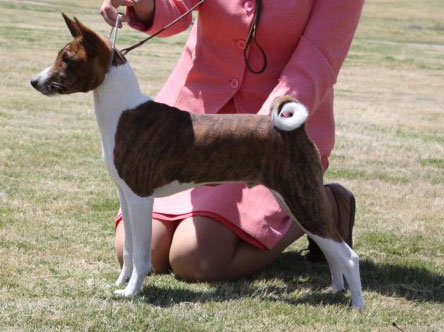 5 month old Pirandello
5 month old Pirandello